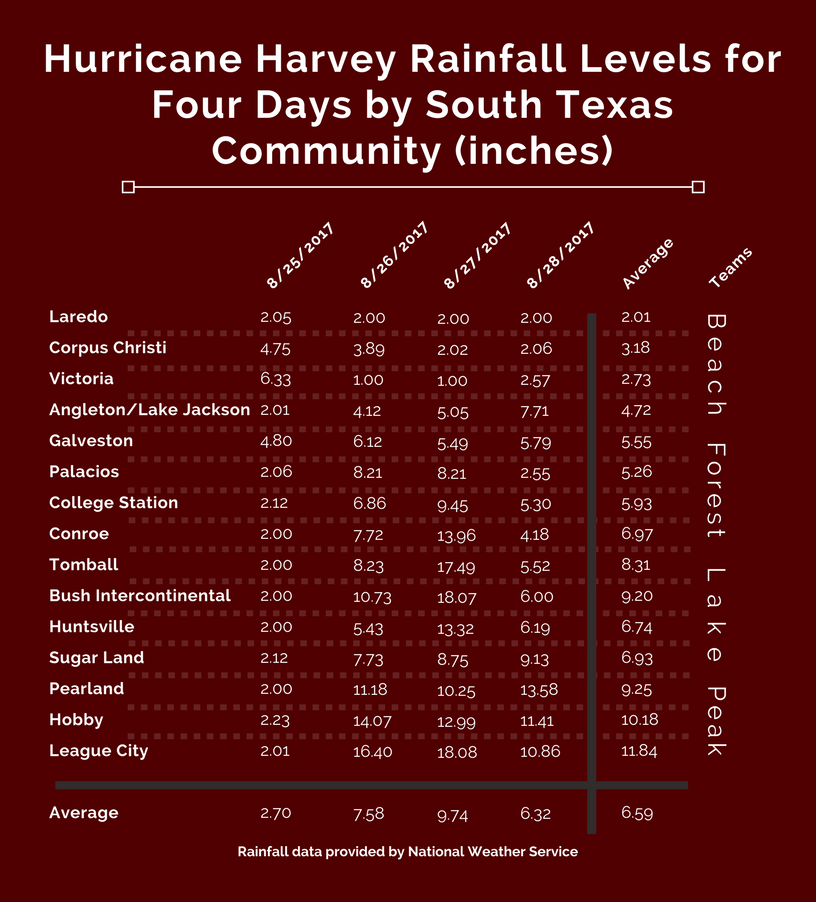Architecture students craft 3-D sculptures with Harvey rain data

Mark Clayton
[See more photos on Tamu Today]
(http://today.tamu.edu/2017/09/22/architecture-students-reflect-hurricane-harvey-rainfall-in-3-d-sculptures/)
Art is imitating life in professor of architecture Mark Clayton’s sophomore architectural design studio at Texas A&M University where students created 3-dimensional wall sculptures that reflect levels of rainfall experienced by residents of more than a dozen South Texas communities during Hurricane Harvey. In the process of depicting the days, inches of rainfall and locations in visually intriguing and symbolic ways, the students also tackled the daunting task of crafting curved surfaces, one of the most complex and challenging tasks in architectural design.
“We have historically placed our students in top architectural firms that produce these complex sensuous forms from curves, trendy architecture that includes some of the most interesting buildings in the world,” Clayton said. “This project also is an examination of the facts of the hurricane, a powerful force of nature we have to contend with, and the start toward a process of understanding the significance of it in our lives — a reflective piece that the students really responded to.”
The class of 18 students formed four teams, each with the challenge of conveying inches of rainfall in three to four cities from Aug. 25, when Hurricane Harvey hit the Gulf Coast, to Aug. 28, in one visually striking and curvaceous 3-dimensional display. The Beach Team covered Laredo, Corpus Christi, Victoria and Angleton/Lake Jackson; the Forest Team depicted Galveston, Palacios, College Station and Conroe; the Lake Team portrayed Tomball, Bush Intercontinental Airport and Sugar Land; and the Peak Team tracked Pearland, Hobby Airport and League City.

“Our team chose to do this kind of oak tree style rib system for each of our graphs, to represent the oak trees of Houston, very strong and rooted in the ground, that will endure past the hurricane, like the people,” said Hayden Hood, 20, a sophomore environmental design major from Austin who was a member of the Peak Team. “Just like the trees, we will endure past all the hardships, and we’ll stand firm and strong through any kind of weather.”
The teams were encouraged to assign a leader to take responsibility for ensuring the success of the project, a head designer to ultimately decide, with input from the team, on the design, and a technical leader to provide guidance with the necessary tools and computer software.
From a fabrication point of view, architects and contractors have flat products in their arsenals, so the challenge is for them to make seemingly curved surfaces by assembling flat elements, Clayton said. In construction, the materials often used include plywood, plate glass, plate steel and plate aluminum.
“The students’ job was to build a structure that could hold a thin cladding at the right position to take on the shape of the surface,” Clayton said. “As sophomores, they need to understand that they are responsible for the assembly and connection of these elements, not the contractors.”
The teams were given the choice of triangulated, shingled, ruled or 3-D printed elements to create their surfaces. With computer-controlled machines in the college’s [Automated Fabrication and Design Lab] (https://fablab.arch.tamu.edu/) at the Riverside campus, they fabricated the elements of their 3-dimensional sculptures from a variety of materials and put them together by hand.
Hood and his Peak teammates used wood, PVC plastic, illustration board and copper wire to create their sculpture. They cut wooden ribs resembling the wavy branches of an oak tree for their foundation, and they created “waterfall-like” surfaces that conformed to the curvy underlying structure with PVC plastic triangles connected by copper wire and rectangles cut from illustration board, with a gap in the middle to expose the structural system.
They precisely measured and cut approximately 150 triangles from white PVC plastic, punched holes in the corners and tied them together with copper wire for the upper half of their sculpture, and they cut more flexible rectangles, or shingles, from illustration board for the lower half.
“We chose shingles because it imitates the roof of a house, like the houses destroyed by Hurricane Harvey, and the triangulated surfaces imitate the canopy of a tree which can be seen as growth, or what is to come from the destruction of Hurricane Harvey,” Hood said. “The crack in the surface can relate to a sense of damage done, and the united triangulated and shingled surfaces can relate to a sense of rigidity and strength.”

Beyond the exercise in symbolism, the project allowed students to combine digital with tactile—to manipulate numbers to create curvature in the computer and to translate those surfaces to sculptures, Clayton said. The students also learned to collaborate as members of a team, an essential skill for any architect.
“In a few years, we will graduate, and we will still have damage in Houston from Hurricane Harvey, and the underlying truth is that this might be what we focus on for the next 10 years,” Hood said. “We will be helping not only to fix what has happened, but to help plan for the future to prevent these circumstances through design of buildings and design of cities.”
Elena Watts
Texas A&M Marketing and Communications
elenaw@tamu.edu.
Tags
Related Posts

Colorful installation gives cafe a facelift
Forum features fortune cookie-fashioned form

Simple panels lead to complex forms in student workshop

Exhibit displays transformable building designs

Design studio tackles indoor architectural lighting challenge
Follow Us
Facebook Twitter Vimeo Youtube Flickr RSS
Recent Posts

Planning prof heads study of disaster housing aid

A message from the dean

Former student remembered as expert planner

Leading educator named new head of Architecture Dept.







_thumbnail_small.png)
